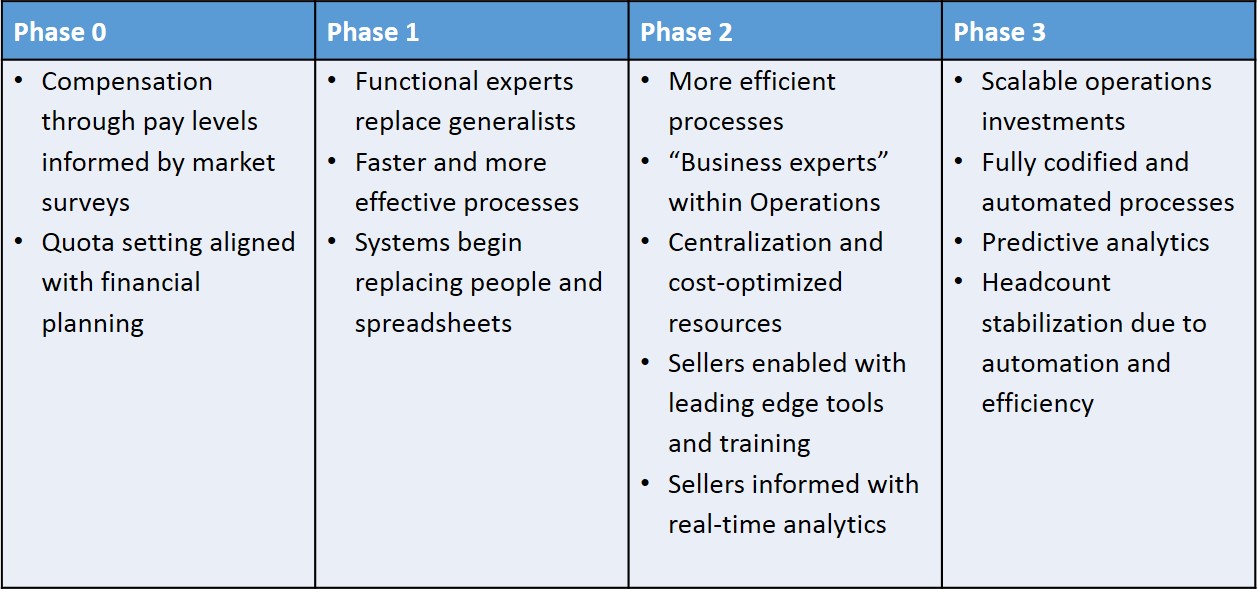The Four Phases of Best Practice Sales Operations Organizations

Sales Operations, Commercial Excellence, Sales Enablement
Whatever the group is called in your organization, the charter remains consistent: Make the sales organization more productive. However, Sales Operations must evolve with the business or risk being marginalized. Sales Operations evolves with the size, complexity and maturity of the business.
As part of a broader study on Sales Operations best practices, the Alexander Group recently interviewed over 25 Sales Operations leaders across the High Tech, Medical Products and Life Sciences industries to understand their charters and objectives. For the Sales Operations function to stay vibrant and relevant it must continue to evolve through four phases. Sales productivity improvement is the consistent theme throughout, but how the team drives sales productivity improvement differs by phase.
Let’s examine the four phases and their key characteristics:
- Phase 0: Shadow Operations
- Phase 1: Sales Operations
- Phase 2: Commerical Operations
- Phase 3: Business Operations
Phase 0: Shadow Operations
Life in this phase is fairly simple. Most companies start out with a single product, going after a single market, via a single or limited number of channels. No formal centralized organization exists. Typical activities are executed by various functions within the company, such as: Finance (e.g., reporting, quota setting and territories); Human Resources (e.g., Sales Compensation, Training and Onboarding) and IT (data management). Productivity in this phase is a function of the tasks getting completed in a distributed fashion.
Phase 1: Sales Operations
The pressure is on! As the business grows and expands, the sales operations function must keep up. Activities previously executed in Shadow Operations are now grouped into a single unit. However, the unit still focuses on core functions such as data management, sales compensation administration, quota setting and territories. Special projects and ad-hoc requests address greater needs. As the company grows even bigger, “mirror” organizations pop up across or within new geographic markets and business units. Duplication of activity is commonplace in this phase as sales operations team structures are completely decentralized. Productivity in Phase 1 results from a more holistic approach to key activities, enabling broader application of best practices and streamlined processes. Inefficiencies decrease as “noise” gets worked out of disparate activities that become more centralized.
Phase 2: Commercial Operations
Now things start to get interesting. As companies expand product lines and routes to market, they require more sophisticated sales operations. In fact the term “sales operations” no longer best describes the charter. Terms such as “sales enablement,” “sales excellence” and “sales strategy and operations” begin to emerge. For lack of a better term, we are calling this phase “Commercial Operations.” Certain functions become centralized (e.g., data management) as the business tries to get more scale out of system and people investments. New functions emerge such as sales enablement (tools and training). Geographic and BU sales operations structures are thinned and key sales operations functions are centralized (and outsourced where efficient), and gain increasing importance within the company. Phase 2 is when sales operations activities begin to organically generate and push higher productivity through accretive responsibility areas like learning & development and business intelligence/analytics. Investments are made in tools to support these productivity-enhancing areas.
Phase 3: Business Operations
An evolved and elevated state for Sales Operations. Companies eventually evolve their business models to require a fourth and final phase. In this phase the majority of Sales Operations functions are now centrally managed and the team operates as a truly shared service. Functions requiring proximity to a business unit and geography such as territory management and sales support stay aligned to regional sales teams, while virtually everything else is aligned to a common, global reporting structure. The centralized unit begins serving more than the sales organization, acting as an “intelligence hub” that provides insights to influence strategy and predictive analytics to support forecasting and planning. The Business Operations function has clear productivity-enhancing measures and is seen as a strategic and tactical productivity multiplier for the organization. The leader of the Business Operations team has earned a “seat at the executive table” and typically participates in strategic company discussions.
What changes across these phases is not the charter, but rather the approach Sales Operations takes to drive productivity. Some groups drive more top line revenue by enabling incremental sales through slick pipeline tools, training resources, sharply crafted territories and highly motivating incentive plans. Others improve the bottom line by replacing field resources with predictive analytics that maximize the value of each sales call, or introducing sales support resources that off-load administrative tasks from core selling roles.
Examples of Productivity Drivers by Phase

Speak With Our Experts
What phase are you in? How do others respond to the pressure to increase sales productivity year after year? Alexander Group can help. Visit our Sales Operations practice.

